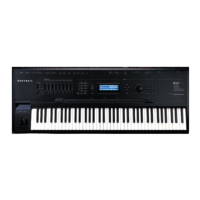7-38
Setup Mode
The Setup Editor
With Velocity set to MIDI 109, MIDI controller 109 continually sets the arpeggiator velocity. This
works well when MIDI controller 109 is set to a knob or expression pedal.
With Velocity set to Fixed, all notes play with the same velocity. The default Fixed velocity is
100. Like MIDI 109, You can control this velocity amount in real-time by assigning a controller
to VelFixed, controller destination number is 175. Input from any physical controller assigned to
send VelFixed (or any entry value for a controller assigned to send VelFixed) overrides the
programmed value of the Velocity parameter, disabling it until you select a different setup (or in
Program mode, until you select a different control setup on the MIDI-mode TRANSMIT page).
Pattern engages a step sequencer for arpeggiator velocity patterns, which shifts the velocity of
each arpeggiated note according to a sequenced pattern. There are 74 pre programed velocity
patterns that you can choose from the VelPatt field, some of which create rhythms by using
velocity values of -127 or “none” to leave rests in the arpeggiation. The sequencer uses the
velocity received from the first note played as the center position to shift velocities up or down
from. If no other keys are playing, patterns will start over each time a key is pressed (there are
some exceptions to this when using ARPEGGIATOR Latch parameters other than “Keys,” though a
newly triggered pattern will always start at step 1.) When triggering velocity patterns from more
than one key at a time, each consecutive step of the pattern shifts the velocity from a different
inputted key, the order of which is decided by the order parameter on the ARPEGGIATOR page.
Note: For patterns with negative velocity values, if the velocity of the first played note is low enough that
a pattern step could result in a velocity of zero, some notes may have a velocity of zero and therefore
produce no sound.
You can edit the included patterns by pressing “Edit” with a pattern highlighted in the VelPatt
field (see edit screen below.) The top line of the “EditVelocityPatt” page displays the pattern’s
name and total number of steps. This page also shows the full name for a pattern whose name
does not fit on the ARPEGGIATOR page. Each pattern can have up to 48 steps, and each step can
shift velocities by ± 127 steps. You can insert a step with a value of “none” by entering -127 and
then shifting down one more step. A step with the value “none” causes the arpeggiator to play
nothing for that step, allowing you to create rhythmic patterns by using “none” to leave spaces.
Pressing Step- removes the last step in the list, pressing Step+ inserts a new velocity step at the
end of the list (the pattern editor remembers the values of removed steps until you save or exit.)
Use the cursor to move between pattern steps, use the alpha wheel, alphanumeric pad, or plus/
minus buttons to enter the velocity shift amount for each step. Press More to see a second page
for patterns with more than 24 steps.
Press Delete to delete the pattern from memory. Press Rename to rename the pattern and save.
Pressing Save gives you the option to save the pattern or rename and save. To create a new
VelPatt, edit an existing pattern and choose Rename when saving. Press Exit to return to the
ARPEGGIATOR page. When exiting the editor, it will automatically give you the option to save
the pattern if changes have been made. For more detailed instructions on these functions, see
Saving and Naming on page 5-3.

